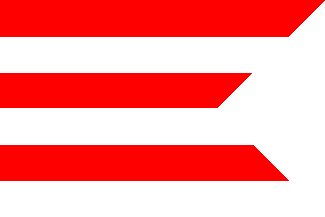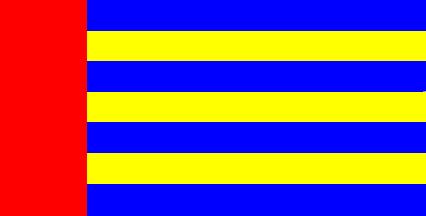
Last modified: 2011-06-03 by andrew weeks
Keywords: sturovo | cockerel |
Links: FOTW homepage |
search |
disclaimer and copyright |
write us |
mirrors
![[Stúrovo new flag]](../images/s/sk-nz_st.gif) by Jarig Bakker, 28 Jan 2002
by Jarig Bakker, 28 Jan 2002
I think this is not the official form of the flag but a standardised
form.
István Molnár, 28 Jan 2002
 submitted through Rob Raeside, 2 Aug 1999
submitted through Rob Raeside, 2 Aug 1999
Štúrovo (original: Parkaň 1920-1948; Hungarian: Párkány) has 13.347
inhabitants (73,5% Hungarian; 1990 census). The town was in Esztergom (Slovakian:
Ostrihom) County of Hungary till 1919/1920 (Czechoslovakian occupation).1920-1938
part of Czechoslovakia, 1938-1944 Hungarian (after the Decision of Vienna).
The Treaty of Paris (1947) reallocated it to Czechoslovakia. The town is
located on the left bank of the River Danube opposite Esztergom city in
the west gate of the Danube-Bend. The original name of the settlement was
Kakat till the Turkish wars. The new Turkish fort 'Dsigerdelen'
was built in the destroyed territory of Kakat village in 1545-1549. About
the small fort new settlement got the new name: Párkány. Parkaň had got the new
name in 1948: Štúrovo. Ľudovíť Štúr (1815-1856) was born in Nyitra/Nitra
County, he was a Slovakian linguistic and poet.
István Molnár, 13 Aug 2000
 by István Molnár, 13 Aug 2000
by István Molnár, 13 Aug 2000
Last Monday I was in the Office of the Community of Štúrovo City and
I got a city flag and a picture about the coat of arms. These are the official
symbols of the town from 1972 designed by the heraldist Dr. Péter Püspöki
Nagy.
István Molnár, 13 Aug 2000
One peek at the map learns that there is huge station-yard near Štúrovo,
which may account for the stripes on the flag.
Jarig Bakker, 13 Aug 2000
sturo.gif) from
http://www.tatrahome.sk/revue/erby/ . (!Link does not work any more!)
from
http://www.tatrahome.sk/revue/erby/ . (!Link does not work any more!)
![[Štúrovo 'official' Coat of Arms]](../images/s/sk)nz-st.gif) sent by István Molnár, 13 Aug 2000, resized by Rich Hansen.
sent by István Molnár, 13 Aug 2000, resized by Rich Hansen.
The coat of arms of Štúrovo/Párkány is a Gothic shield divided into two fields.
The blue color symbolizes the meeting of the rivers: the Danube and the
Hron/Garam. The gold (or yellow) triangle relates to the ground plan of
the former fort. In the yellow field is a red cock looking right, referring
to the original name of the settlement (Kakat or kakas means cock in Hungarian).
The red color and the five-pointed comb refer to the five greatest calamities
in the settlement (in 1529, 1532, 1543, 1595, 1683, in the time of the
Turkish Wars)
István Molnár, 13 Aug 2000